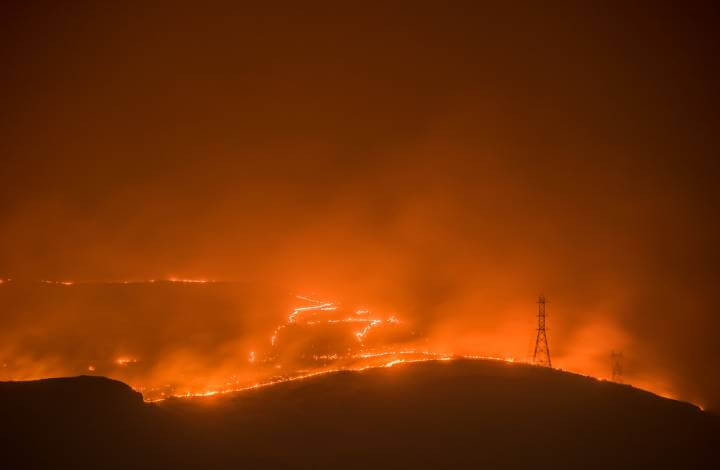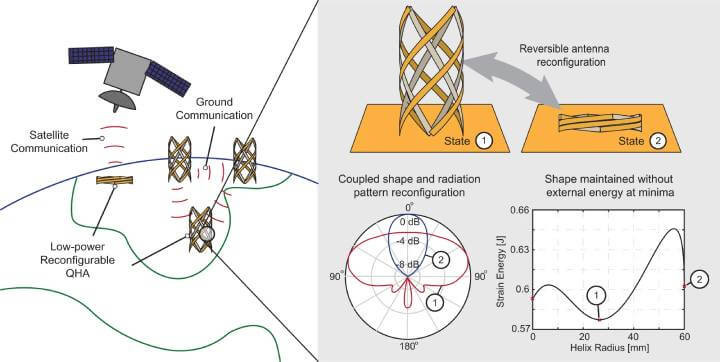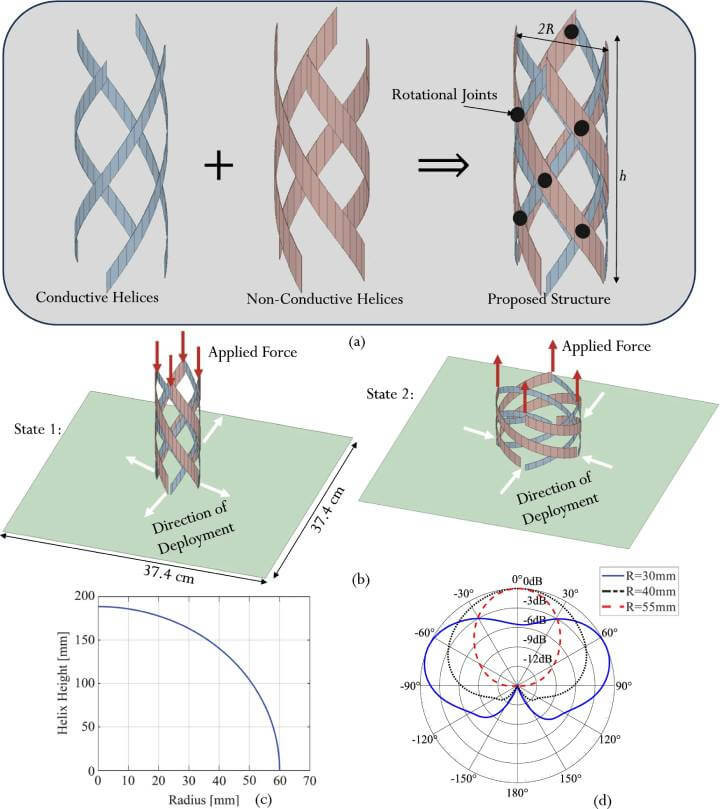Bi-Stable QHA: Enhancing Communication in Disaster Zones
23-01-2024 | By Liam Critchley
Key things to know:
- Bi-Stable QHA Design: A breakthrough in antenna technology, offering seamless switching between terrestrial and satellite communication modes without external power.
- Adaptability in Disaster Zones: Specifically designed for areas with limited infrastructure, ensuring robust communication during natural disasters.
- Innovative Mechanism: Features counter-rotating helical strips and rotational joints, enabling manual reconfiguration and height/radius variation.
- Lightweight and Portable: Weighing only 39g (antenna) and 737g (with ground plane), significantly lighter than traditional large dish antennas used in disaster areas.

Natural disasters are becoming increasingly common and more destructive amid changes in the global climate and devastate many regions of the world. Many natural disasters damage and destroy the communication infrastructure in the regions that are the most affected, making it extremely difficult to coordinate research efforts on the ground—and it is especially difficult in technologically underdeveloped regions that lack a wide array of communication infrastructure.
Innovative Antenna Solutions for Disaster Communication
The innovative design of the bi-stable QHA addresses critical challenges in disaster communication. Its ability to switch between terrestrial and satellite modes without external power is a breakthrough, especially in areas where power sources are scarce. This feature is crucial for ensuring continuous communication during prolonged disaster scenarios, where traditional power infrastructures are often compromised.
To better illustrate the innovative design and functionality of the bi-stable quadrifilar helix antenna, let's examine Fig. 1. This figure provides a visual representation of the antenna's operational concept, specifically tailored for use in disaster-prone areas. It highlights the antenna's unique structure and its ability to switch between different communication modes, offering a clearer understanding of how it operates in challenging environments.
Fig. 1: Operational concept of the multi-stable deployable and reconfigurable quadrifilar helix antenna for Disaster-Prone Areas.

Overview of the integrated structural and electromagnetic reconfiguration employed in the low-power quadrifilar helix antenna designed for use in areas with limited infrastructure.
Antennas are currently deployed to disaster zones, but modern-day systems use large dish reflectors that are difficult to deploy and move and lack the necessary performance to enable both terrestrial and satellite communications within areas that have little communication infrastructure. There’s a growing interest and need to create antenna systems that can easily be deployed on demand and have a reconfigurable performance that can adapt to different circumstances on the ground.
There are many different types of antenna architectures that can be deployed, including helical antennas, conical log spirals, quadrifilar helix antennas, origami and kirigami structures. Deploying into disaster zones is only one-half of the battle. The other challenge is the ability to reconfigure their operational frequencies, alternate their radiation patterns, or achieve polarisation reconfiguration on demand to meet the communication needs on the ground. Merging both deployable and reconfigurable properties in an antenna requires actuators to change the topology of the antenna and bring about functional changes.
This can be a technological challenge, but researchers are looking at how to deploy antenna systems on demand and change their performance based on the ever-changing circumstances during a natural disaster and during the aftermath—all while being lightweight and using a minimum amount of power. Creating antennas with low power usage helps to deploy them in areas with less electrification and communication infrastructure present, allowing them to work for longer.
The antenna's design is particularly noteworthy for its use of counter-rotating helical strips, which are a novel approach to achieving bi-stability. This design allows for a rapid and manual reconfiguration of the antenna's operational state, which is essential in the fast-paced and unpredictable environment of a disaster zone. The integration of fiber-reinforced composites adds to the antenna's durability, ensuring it withstands the harsh conditions often encountered in such scenarios.
Building a New Reconfigurable Antenna Architecture
Researchers have now come up with a new antenna design: a bi-stable quadrifilar helix antenna (QHA) that can reconfigure its pattern and polarisation to facilitate on-demand terrestrial and satellite communications. The reconfiguration process is a manual process which removes the need for an external power supply and has been designed with areas in mind that lack localised electronic and communication infrastructure—as these areas tend to be underdeveloped in a number of aspects and often suffer most at the hands of natural disasters, whereas technologically advanced societies have more modern-day solutions to minimise the damage and loss of life.
The antenna built by the researchers utilises counter-rotating helical strips that are connected by rotational joints. The antenna is composed of four conductive strips that are wound in a counterclockwise direction and four dielectric strips that are wound clockwise. The rotational joints are not conductive and allow the antenna to vary its height and radius through an applied mechanical force.
To further elucidate the antenna's innovative design, Figure 2 from the referenced Nature article offers an in-depth look at its structural and functional elements. This figure visually breaks down the antenna's complex design, showcasing the interplay of its various components and how they contribute to its bi-stability and reconfigurability. Understanding these design elements is key to appreciating the antenna's adaptability and effectiveness in disaster-stricken areas.
Fig. 2: Detailed design and mechanism of the bi-stable reconfigurable quadrifilar helix antenna, as illustrated in the Nature article.

(a) Structure and topology of the antenna. (b) Concept and mechanism of antenna reconfiguration. (c) Correlation between helix height and radius for the strip length (l = 188.5 mm) and total number of turns (N = 0.5). (d) Variation in radiation pattern with radius at 1.1 GHz.
Advanced Features and Functionalities
Each of the helical strips in the antenna are composed of fibre-reinforced composites and the rigidity in the material structure enables the antenna to adopt two stable deployed states that are also self-locking. These two configurations also represent the lowest energy states for the material, so even if the antenna becomes deformed during operation, it will return to one of the two functional states naturally.
The self-locking feature of the antenna's two stable states is a significant advancement. This ensures that once deployed, the antenna maintains its configuration without the need for continuous adjustments. This stability is particularly important in disaster scenarios where human resources are limited, and the focus needs to be on rescue and recovery efforts rather than on maintaining equipment.
The antenna reconfigures between an omnidirectional pattern that enables point-to-point terrestrial connectivity for terrestrial communications and a circularly polarised pattern that generates circularly polarised waves in the L-band (1-1.2 GHz) that can be used for satellite communications—even in areas where there is no communication infrastructure.
The transition between the two communication states is achieved by a sliding mechanism, and the reconfiguration is achieved when a small vertical force is applied to the tip of the antenna. The terrestrial state for communication on the ground is achieved when the antenna is vertically orientated. The force on the antenna in these states causes the strips to slide onto a ground plane (rather than stay in a vertical arrangement) where the structure lies flat on the ground. When the antenna is changed and altered to fit on the ground plane, it still maintains operations within the L-band to communicate over longer ranges.
The sliding mechanism for transitioning between communication states is a key innovation. It not only simplifies the operation of the antenna but also minimises the risk of mechanical failure. This reliability is crucial in disaster scenarios, where equipment failure can have dire consequences on communication and coordination efforts.
The antenna couples mechanical and electromagnetic design to enable multiple communication functionalities. The antenna can be connected to off-the-shelf RF transceivers, and these transceivers can be easily integrated into the antenna’s structure. RF transceivers that are integrated into the antenna can be powered by batteries and be used to transmit and receive modes through the antenna. Once the transceivers are connected to the antenna, its input power is the only power that is required to operate the system.
The integration of off-the-shelf RF transceivers into the antenna’s structure is a strategic choice that enhances the antenna's versatility. This allows for easy replacement or upgrades without needing to modify the antenna structure itself, ensuring the system remains up-to-date with the latest communication technologies.
Overall Outlook
The work done in this study ensured that the antenna can be repeatedly reconfigured into the two desired geometries that have specific electromagnetic properties for promoting terrestrial (ground-to-ground) and satellite communications.
The antenna that has been designed has an enhanced functionality that enables a high gain, as well as directional and circularly polarised operations and an operating frequency in the L-band that remains fixed after rearrangement. The ability to maintain the communication capability between transmitting modes is something that is not usually seen with other reconfigurable antenna systems.
The antenna's high gain and directional capabilities in its reconfigured state are critical for establishing strong and reliable communication links in disaster areas. These features enable the antenna to overcome the common challenges of weak signals and interference, which are prevalent in chaotic post-disaster environments.
While the reconfigurability does not affect the communication efficiency, it is one of the key aspects of the design. Its lightweight, portable, and low-energy characteristics are some of its other key advantages. The weight savings in the design are significant, with the antenna only having a weight of 39g and a total weight of 737g when the ground plane is also taken into account. Compared with the metallic dishes—which weigh around 20 kg—that are usually deployed to disaster areas, these antennas offer some significant weight savings, making them easier to deploy, pack up, and redeploy where needed.
References:

